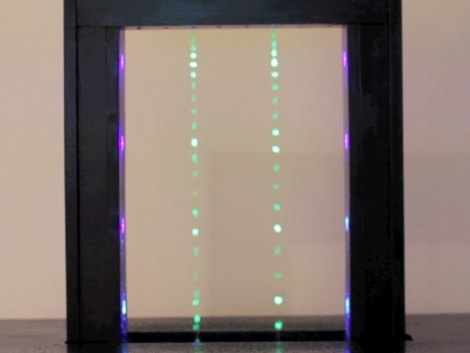This water sculpture can stop drops of water in mid-air. This is accomplished by flashing LEDs to illuminate the droplets at just the right time. But it’s not limited to blinky lights alone. The top of the frame has eight nozzles, each fed by its own pump. An Arduino controls the pumps and the lights making it possible to create different motion effects by adjusting how events line up. For instance, the image above shows just two of the water nozzles on, but in the video after the break it appears one is dripping downward while the other is dripping upward.
Alas, there’s few build details for this but the source code is available for downloading. If we were going to build one of these ourselves we’d probably try to regulate the drips using some solenoids built from scratch. How would you do it? Leave your ideas in the comments.















first I thought “bah.. a waterfall…” but after looking at the video I gotta say it looks pretty awesome.
he’s not a man of many comments. would love some more information about the code but that’s going to take a long time to understand.
i envy people that can efficiently code like he did.
Not bad!
I had seen the same project a couple of years back: http://cre.ations.net/creation/the-time-fountain
Wow amazing result and indeed the code is well writen,on the other hand i think it could have been better without the virtual functions and with a less Object Oriented design but still very well writen.
Mark II could be RGB LEDs and 2D 8X6 nozzles which would make 3D effects similar to those hacks which use jungle of 3D LEDs
Ooh, a multi-band time fountain. This has to be further hacked into a VU meter.
It is a pretty awesome project, and I cannot even begin to think as of how he came up with such an idea!
What’s the music? I like :)
http://matthack.com/category/the-time-fountain-remake/
I haven’t updated my website in a long time but here is my version of the time fountain from high school.
Turn it into an equalizer.
Nice project. But a piece of screen down at the bottom will keep it from splashing.
I built something similar some time ago.
The post is in portuguese, but the code is self explanatory. I’m no engineer and no programmer… but the result was nice. :)
http://copirraite.wordpress.com/2009/10/08/maquinadotempo/
Just wondering, can we expand on this idea?
Build a nice array of let’s say 64 by 64 nozzles and use it as a very low res hologram device? (think mass effect).
if you want a low res hologram what I think would make more sense is to have big block of gel with an array of bubbles suspended in it and a laser array all along one side. you could handle scanlines by then sending a sound pulse 60 times a second of sound that resonates with the bubbles.
the sound pulse would vibrate the bubbles into the path of the lasers. you then just apply this pulse diagonally across the block and you now have scanlines. you offset each color of the lasers along different points in the bubbles path as it vibrates and it’s a color hologram.
also water droplets dont fall fast enough to allow proper scanlines and you wouldn’t be able to get color.
Still better than the shitty Pepper’s Ghost that big expensive shows are using nowadays as “holograms”. If it were up to me, I’d sooner reanimate Michael Jackson’s corpse than use a cheap trick projecting onto glass.
Nice work! I just happen to have a signed copy of an Edgerton book on strobes too!
I hoped to see a single droplet dripping very slowly, or changing pace with each drip, maybe reversing back up into the nozzle!
Perhaps the nozzles can’t spit just a single drop. It looks like they open and close at a preset frequency. For sure the controller could send different pulses to the nozzles if they could work otherwise.
I think you’d need to do that on a planet with much heavier gravity. Since of course it’s a different droplet for each “frame” of the “animation”. To do what you suggest, you’d need to illuminate a succession of droplets at the right time.
Problem is, you’d need to do several flashes a second, but each droplet would have to have gotten out of the way before the next one’s lit up. That’s not possible on Earth. For it to be effective, the flash rate needs to be set to something according to the human eye. The droplets fall according to gravity. So there’s 2 time constraints you can’t alter. Which means you can do a lot of nice effects, but single droplets, no.
Apart from that though you should be able to do all the stuff you mention, just with several drops at once.
Have a slim translucent arm rotating perpendicular to the drops slap/move the adjacent droplets out of the way?
In 2008 one of the first Hack A Day blog posts which glued me to this site was a “Time Fountain” – I can’t find the original article on here, but this is the hypnotic video: https://www.youtube.com/watch?v=rvY7NGncCgU